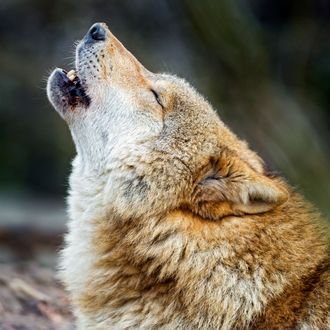
Contrary to what Ozzy Osbourne may have told you, wolves don’t bark at the moon. They howl at each other. Yet the signature (haunting) sound of one of the world’s most social nonhuman animals is only starting to be understood.
It’s part of one of the most exciting developments in comparative psychology (that is, investigating the behavior of nonhuman animals): All sorts of voluble creatures exhibit speech traits that science thought only humans had. Birds can be grammar nerds. Cats really are talking to you. Whales have regional accents, as do cows and macaques. Over the past 50 years, Syracuse University researcher Holly Root-Gutteridge notes at Aeon, studies have found that wolves have individual voices and that wolves within a pack share similar vocalizations (like humans, they’re friendlier to familiar howls). But scientists didn’t know if, like whales’ vocalizations, wolves’ had regional differences, or how one subspecies compared with another.
So Root-Gutteridge, working with a team assembled by Cambridge University zoologist Arik Kershenbaum, put together a collection of 2,005 howls from 13 canid subspecies, from the New Guinea singing dog to the North African wolf to the golden jackal to the domestic dog. Then things got data-y: The researchers used dynamic time warping — a process that’s been used to analyze dolphin chirps — to quantify the “shape” of the wolf’s howl. They found that while each subspecies had its own signature howl type, there were strong similarities between species and subspecies that shared geography or body size.
Root-Gutteridge puts the music into words:
An Eastern grey wolf, recorded in the US, sounded more like a North Carolinian red wolf than a European wolf, and an African jackal sounded quite different again. Small and delicate compared with their cousins the European wolves, golden jackals have high, rising howls, running up and down the scales in bravura performances of control and speed, but with less variation in overall shape, whereas the European wolves used a slower style of deep and steady long notes ending in falls that seem to drift away into the night. New Guinea singing dogs earned their names with a large vocal repertoire and a wide selection of howl shapes.
Without anthropomorphizing too much, there are analogies to be drawn between the similarities found in wolf and human vocalizations. It looks like there’s something similar to the Romance languages of Europe going on: The geographically similar French, Italian, Spanish, and Portuguese share boatloads of cognates, especially in the most basic phrases, and there’s a similar regional affinity in lupine vocalizations. Indeed, Root-Gutteridge also found that wolves will adapt their howls if need be, as was the case of the critically endangered American red wolf, which has a “worrying propensity to mate with coyotes and interbreed with Eastern wolves.” Sonically, the howl of the red wolf fits in between that of the coyote and the Eastern. One result of the interspecies howling is obvious: hybrid pups that, while presumably cute, further imperil the remaining population of red wolves.
Wolf vocalizations, Root-Gutteridge notes, are more like “public shouts” than private whispers, but beyond that, there’s lots left to learn about the purpose of howling. For example, what would the difference be between a get-the-hell-out-of-my-forest howl and a hey-guys-there’s-tons-of-food howl, if there is one? While the data isn’t there yet to say whether there’s “meaning” as humans ascertain it in the howl, Root-Gutteridge, the acoustically attuned biologist, hears it. “To my ears, a happy wolf surrounded by a pack has a very different howl to a lone voice crying in the wilderness, and a love duet with a mate does not match the chorus howl made with the new pups raising their tiny heads to the sky, but all the sounds are beautiful,” she says. In the meantime, here’s an idea for making more use out of that ridiculously extensive library of wolf sounds: With a drum machine, a couple guitars, and the right sampler, you could make some seriously avant-garde death metal.

